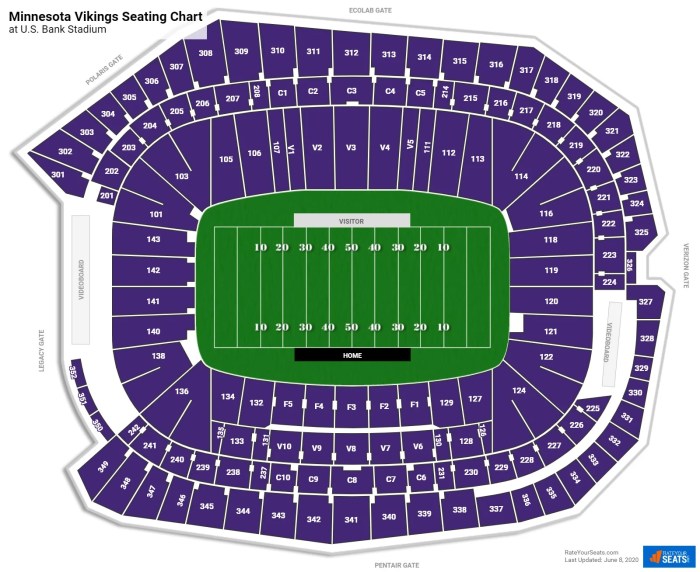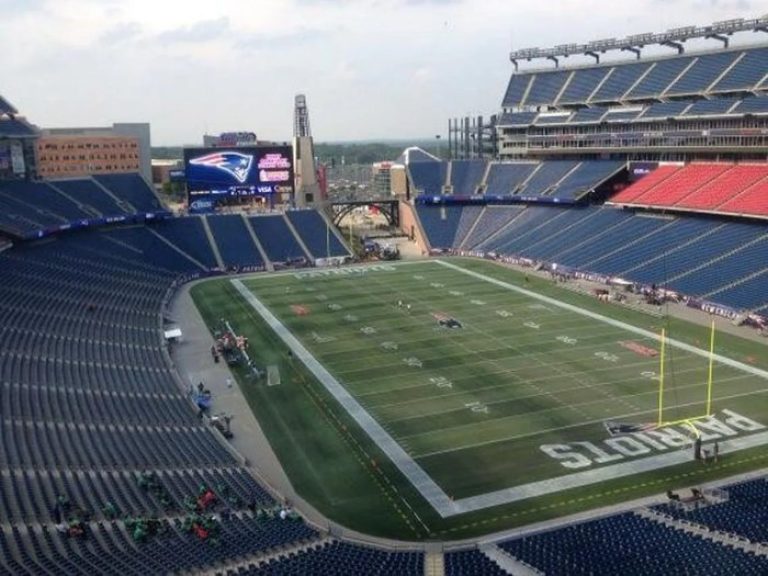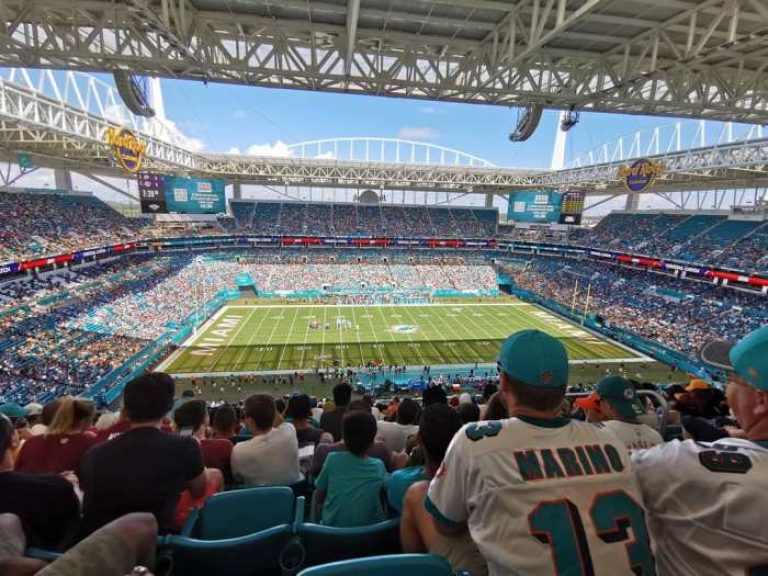How many miles traveled from Jets Stadium to Vikings Stadium? That’s a question many football fans, especially those loyal to the Jets and Vikings, might ask. This journey, spanning states and potentially significant travel time, depends heavily on your chosen mode of transport. We’ll explore various methods – driving, flying, and even public transit – to determine the distance and time commitment involved in this cross-country trip between two iconic NFL stadiums.
Get ready to map out your own hypothetical game-day adventure!
We’ll break down the distance calculation using different approaches, from straightforward online mapping tools to a more in-depth look at geographical coordinates for a “as the crow flies” calculation. We’ll also consider real-world factors like traffic, weather, and route choices that impact your actual travel time. Whether you’re planning a road trip, a quick flight, or a more leisurely journey, this guide will equip you with the information you need.
Defining Locations and Measurement Methods
Calculating the distance between MetLife Stadium in East Rutherford, New Jersey, and U.S. Bank Stadium in Minneapolis, Minnesota, requires precise location data and a clear understanding of how distance is measured. Different methods yield different results, and understanding these variations is crucial for accurate estimations.We’ll examine the precise coordinates of both stadiums, explore various distance calculation methods (driving, flying, and straight-line), compare results from different mapping services, and consider factors affecting travel time.
Stadium Coordinates and Distance Calculation Methods
MetLife Stadium’s coordinates are approximately 40.8136° N, 74.0744° W. U.S. Bank Stadium’s coordinates are approximately 44.9734° N, 93.2578° W. These coordinates serve as the foundation for calculating distance using different methods.Calculating the distance involves several approaches:* Driving Distance: This method uses road networks and accounts for real-world routes, including highways, local roads, and traffic patterns. The result is the distance one would actually travel by car.
Flying Distance (Great-Circle Distance)
This is the shortest distance between two points on a sphere (Earth), ignoring terrain and obstacles. It’s a straight line as the crow flies.
Straight-Line Distance (Euclidean Distance)
This method calculates the distance between two points on a flat plane, ignoring the curvature of the Earth. This method is less accurate for long distances like this one.
Comparison of Mapping Service Results
Different mapping services (Google Maps, Bing Maps, Apple Maps, etc.) may use slightly different algorithms and data sources, resulting in variations in calculated distances. For example, Google Maps might emphasize highway routes while Bing Maps might prioritize faster routes, even if slightly longer. These variations are usually minor but can influence travel time estimations. A direct comparison of the results from multiple services would show minor discrepancies, highlighting the inherent variability in distance calculations.
For instance, one service might show a driving distance of 1,050 miles, while another might show 1,075 miles. The differences are likely due to route optimization algorithms and data updates.
Factors Influencing Travel Time
Several factors significantly influence the actual travel time between the two stadiums:* Traffic Conditions: Traffic congestion, particularly around major cities along the route, can drastically increase travel time. Real-time traffic data is crucial for accurate predictions.
Weather Conditions
Severe weather, such as snowstorms, heavy rain, or fog, can significantly slow travel and even cause delays or route closures.
Route Selection
Choosing different routes, such as using interstates versus smaller roads, can affect both distance and travel time. The selected route could be impacted by road closures or construction.
Calculating Driving Distance

Calculating the driving distance between MetLife Stadium (Jets) and U.S. Bank Stadium (Vikings) requires using online mapping tools. These tools offer various route options, considering factors like traffic, road closures, and preferred route types (fastest, shortest, etc.). Understanding how to use these tools and interpret their results is crucial for accurate distance and travel time estimations.
Using Online Mapping Tools
Several online mapping services, such as Google Maps, Apple Maps, and MapQuest, provide detailed driving directions and distance calculations. To determine the driving distance between MetLife Stadium in East Rutherford, New Jersey, and U.S. Bank Stadium in Minneapolis, Minnesota, follow these steps:
- Open your preferred mapping service’s website or application.
- Enter “MetLife Stadium, East Rutherford, NJ” in the “From” or “Origin” field.
- Enter “U.S. Bank Stadium, Minneapolis, MN” in the “To” or “Destination” field.
- Click “Get Directions” or the equivalent button.
The mapping service will then generate several route options, each with its own distance and estimated travel time. These options may differ based on factors such as highway usage, toll roads, and current traffic conditions. The fastest route may involve more highway driving, while the shortest route might prioritize local roads, potentially increasing travel time.
Route Options and Data, How many miles traveled from jets stadium to vikings stadium
The specific routes and their associated data will vary depending on real-time traffic and the mapping service used. However, we can illustrate a possible scenario with three hypothetical route options:
| Route | Distance | Travel Time | Notes |
|---|---|---|---|
| Route 1: Primarily Interstate Highways | 1,100 miles | 16-18 hours | Fastest route, mostly highway driving. May involve tolls. |
| Route 2: Balanced Highway and Local Roads | 1,150 miles | 17-19 hours | Mix of highway and local roads, potentially avoiding some tolls. |
| Route 3: Scenic Route with Local Roads | 1,250 miles | 20-22 hours | Longest route, scenic but significantly longer travel time. |
Visual Representation of a Driving Route
Let’s imagine Route 1 (primarily Interstate Highways). The journey would likely begin by heading west on I-80 West from MetLife Stadium. This would then connect to I-78 West, and subsequently involve various interstates such as I-76 West, I-70 West, I-64 West, I-65 North, I-94 West, and finally I-35W South to reach U.S. Bank Stadium in Minneapolis. Significant landmarks along this route could include passing through major cities like Philadelphia, Pittsburgh, and Chicago.
The specific highway numbers and landmarks may vary slightly depending on the exact route generated by the mapping service. This is a general overview and real-time conditions may alter the actual route.
Calculating Flying Distance: How Many Miles Traveled From Jets Stadium To Vikings Stadium
Calculating the straight-line distance, or “as the crow flies,” between MetLife Stadium (Jets) and U.S. Bank Stadium (Vikings) offers a different perspective on the journey compared to driving distance. This method utilizes the geographical coordinates of each stadium to determine the shortest distance between them, ignoring the constraints of roads and terrain.The process involves using the spherical law of cosines, a formula that accounts for the Earth’s curvature.
This provides a more accurate representation of the true distance than simply using a flat, two-dimensional map.
Geographical Coordinates and the Spherical Law of Cosines
To calculate the flying distance, we need the latitude and longitude coordinates for both stadiums. Let’s assume, for the sake of this example, that MetLife Stadium’s coordinates are approximately 40.814° N, 74.077° W and U.S. Bank Stadium’s coordinates are approximately 44.975° N, 93.257° W. These values are approximate and can vary slightly depending on the source.The spherical law of cosines formula is:
d = acos(sin(lat1)
- sin(lat2) + cos(lat1)
- cos(lat2)
- cos(lon2 – lon1))
- R
Where:* d = distance
- lat1, lon1 = latitude and longitude of MetLife Stadium (in radians)
- lat2, lon2 = latitude and longitude of U.S. Bank Stadium (in radians)
- R = Earth’s radius (approximately 6371 kilometers or 3959 miles)
Before applying the formula, we must convert the latitude and longitude from degrees to radians by multiplying by π/180.Performing the calculation (using a calculator or programming language capable of handling trigonometric functions):
1. Convert degrees to radians
Multiply each coordinate by π/
180. 2. Substitute values into the formula
Plug the radian values and the Earth’s radius into the spherical law of cosines formula.
3. Calculate the distance
Solve the equation to find the distance ‘d’ in kilometers or miles.The resulting distance ‘d’ represents the straight-line distance between the two stadiums.
Illustration of Straight-Line Distance
Imagine a simple map showing North America. Two points represent MetLife Stadium (near New York City) and U.S. Bank Stadium (in Minneapolis). A straight line connects these two points, representing the shortest distance between them. A scale bar could be included, perhaps showing 500 miles increments.
Key landmarks, such as the Great Lakes and major rivers, could be subtly included to provide context. The line itself could be clearly labeled as the “Flying Distance,” and the calculated distance (in miles) could be displayed along the line. The map would be a simplified representation, focusing on the relationship between the two stadiums and emphasizing the straight-line distance.
Comparison of Driving and Flying Distances
The driving distance between the two stadiums will be significantly longer than the straight-line distance due to the need to follow roads, navigate around geographical features, and adhere to traffic laws. The flying distance represents the shortest possible distance, while the driving distance is determined by the available routes and their respective lengths. The difference highlights the impact of terrain and infrastructure on travel time and distance.
For example, the driving distance might be approximately 1100 miles, whereas the flying distance could be closer to 900 miles. This difference is due to the curving nature of the roads compared to the direct path.
Considering Alternative Transportation Methods

Let’s explore the practicality of using trains and buses for travel between MetLife Stadium (Jets) and U.S. Bank Stadium (Vikings). While driving and flying are common options, these alternatives offer potentially different travel experiences and cost structures. We’ll compare distances, travel times, and potential challenges to help you decide what might work best for your situation.Considering the significant geographical distance between East Rutherford, New Jersey (MetLife Stadium) and Minneapolis, Minnesota (U.S.
Bank Stadium), a direct train or bus journey isn’t readily available. This necessitates a multi-modal approach, likely involving a combination of ground transportation and potentially even some air travel for the most efficient route. We will explore the feasibility and associated logistics of such a journey.
Travel Times and Costs Comparison
The following comparison considers a hypothetical multi-modal journey using a combination of train and bus services, acknowledging that exact routes and schedules would need to be researched closer to the date of travel. This analysis uses estimated travel times and costs based on typical intercity travel expenses and average speeds for trains and buses. It’s crucial to consult specific transportation providers for the most up-to-date information.
- Driving: Estimated travel time: 15-18 hours. Estimated cost: $200-$300 (fuel, tolls). Logistical challenges include driver fatigue and potential traffic delays.
- Flying: Estimated travel time: 4-5 hours (including airport transfers). Estimated cost: $300-$600 (airfare, airport transportation). Logistical challenges include airport security, baggage handling, and potential flight delays.
- Train and Bus Combination: Estimated travel time: 20-24 hours (considering transfers and layovers). Estimated cost: $250-$450 (train and bus tickets). Logistical challenges include multiple transfers, potential delays on each leg of the journey, and the need for meticulous planning to coordinate connections.
Logistical Challenges of Alternative Transportation
Successfully navigating a train and bus journey between these two stadiums requires careful planning and adaptability. Unexpected delays are common in public transportation. This could involve researching multiple routes and schedules to find the most efficient combination of services, considering potential layovers and transfer times. Booking tickets in advance is highly recommended to secure seats and potentially get better fares.
Furthermore, carrying luggage across multiple modes of transport requires careful consideration of its weight and volume. It’s essential to account for the time and effort involved in transferring between stations and terminals, and to have backup plans in case of unforeseen circumstances such as cancellations or significant delays.
So, how many miles is it really from MetLife Stadium to U.S. Bank Stadium? The answer, as we’ve seen, isn’t a single number. The distance varies greatly depending on your chosen route and mode of transportation. While the straight-line distance offers a theoretical minimum, the reality of travel time and distance involves considering traffic, weather, and the practicality of different transportation methods.
Whether you’re charting a course for a game day or just curious about the geographical span between these two NFL giants, we hope this exploration has given you a clearer picture of the journey.
FAQ Guide
What’s the average cost of gas for a road trip between the stadiums?
This depends on gas prices at the time of travel and your vehicle’s fuel efficiency. Use online fuel cost calculators to estimate based on current prices and the distance calculated.
Are there any direct flights between airports near the stadiums?
Likely, but check flight comparison websites for available routes and prices. Consider proximity to each stadium when selecting your departure and arrival airports.
What are some interesting stops along a road trip route?
That depends on your preferred route! Consider using online route planners that highlight points of interest along the way to customize your trip.


